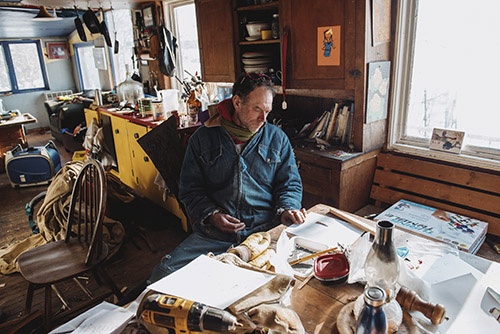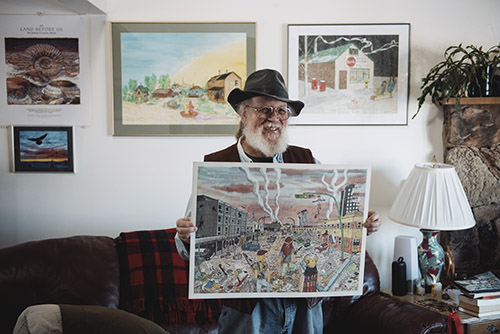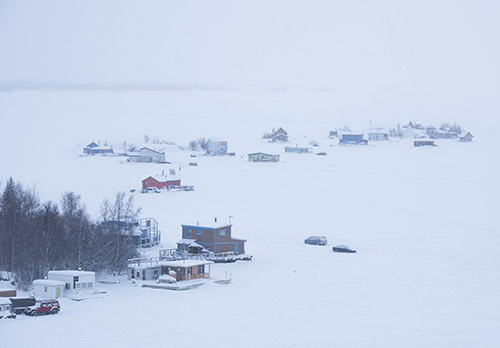 Photographs by Pat Kane
Photographs by Pat Kane
Different Strokes
Yellowknife eschews art-world elitism, writes Sarah Swan. Could it be Canada’s capital of Outsider Art?
If Toronto is the dad of the Canadian art world, Montreal and Vancouver are its moms. Halifax and Winnipeg are the snotty-nosed kids, fighting for attention. And Yellowknife is a weird, distant cousin you’ve never met.
In the capital city of the Northwest Territories, population twenty-two thousand, people skidoo to work. Wolverines occasionally prowl the streets. Two of the most popular leisure activities are stacking wood and salvaging at the city dump. For years, the Ugly Truck and Dog contest celebrated husky-mutt hybrids and rust-eaten, antler-festooned F-150s. Yellowknife is a wonderfully eccentric place to live, providing so much grist for the creative mill, despite the fact—or maybe because of the fact—that it’s so far away from the art world’s centres of power.
While there are a handful of professional artists here, there is no public gallery and almost no art infrastructure. Most Yellowknife artists are not recognized beyond northern borders. They arrange DIY art shows in their sheds, or set up outdoor art installations in yards. Occasionally, there are hide-tanning camps in the Somba K’e park downtown, run by Dene Nahjo, an organization of local creatives dedicated to revitalizing the practice. Local artist Mike Mitchell, aka “Birch King,” sets up an annual bush gallery at the site where he taps birch trees, perching his Sharpie-on-scrap-wood drawings in the branches. The trees are his collaborators, acting as repositories for his on-the-fly impressions of life in the bush.
Artists in Yellowknife are marginalized because of geographical remoteness, but also because of art-world elitism. Pick from these pejorative terms: our artists are often self-taught-folk-hobby-outsider artists who might only paint on Sundays. But our best artists make work that is frequently superior to art-world art. It brims with idiosyncrasy and is free of convention. As Canadian art historian Michael Bird once wrote, the best examples of folk art become indistinguishable from modern art anyway.
Hello Moms, Dad and snotty-nosed kids. Meet cousin Yellowknife, the Outsider Art capital of Canada.
The prevalence of Outsider Art—art by artists with little to no contact with the mainstream art world—is growing internationally. There has been an Outsider Art Fair in New York since 1993, and many outsiders, like Judith Scott, Bill Traylor and Daniel Johnston, have earned art-celebrity status. Ironically, though these artists were excluded from the mainstream art world because of their race, class, lack of formal education, rural location, or their struggles with mental health, these outsiders are now in.
In 2018, curator of modern art Lynne Cooke staged a discourse-altering exhibition, “Outliers and American Vanguard Art,” at the Los Angeles County Museum of Art. Outlier, she said, is a preferable term to Outsider, as it suggests “that an artist’s distance from centers of institutional power can create space for different goals or values.” Not every artist makes art as a form of academic research. Not every artist wants to contribute to “art discourse.” They might, however, value the profound sense of satisfaction that self-expression gives, or simply want to share the way they see the world.
Canada’s artscape is vastly different from America’s, and though we have pushed for important canon interruptions—first in the name of feminism and more recently in the name of decolonization—we have yet to make significant room in our galleries for artists who are not formally educated. Much of our gallery art in Canada is made by artists with a Master of Fine Arts degree, which has turned Canadian art into a never-ending feedback loop of mutual, insider influence.
Canada has not yet recognized the potential of Outsider/Outlier art as an exciting corrective to its classism. Outlier art reminds us that art is everywhere. So why not explore art that has roots in the real world, rather than a rarefied one?

Yellowknife creativity existed long before Yellowknife itself: in the beadwork and sewing of the Yellowknives Dene and the nearby Tłı˛cho˛ Dene who have inhabited the region for thousands of years. Beading on moose or caribou hide began post-contact, since beads were introduced by colonizers. But beauty and adornment was part of Dene craft for at least hundreds of years prior to that, as garments were richly decorated with quills.
Yellowknife art in the Western, or colonial, sense of the word was born on the rocky shores of Great Slave Lake. Old Town, Yellowknife’s first settler neighbourhood, originated in the 1930s, a few mud paths and wooden shacks slapped together by gold seekers from the south. These rugged settlers named a particularly muddy road Glamour Alley. They built a line of outhouses and called it Privy Row; it later became Ragged Ass Road, which is still its name today. Their raffish, unmannered wit became the DNA of Yellowknife settler art.
As a frontier town, Yellowknife attracted unconventional types, especially in the sixties and seventies: hippies and adventure-seekers from the south. With each hippy migration, the number of shacks grew. These were brightly painted—turquoise, red, yellow—and decorated with jerry cans, old boots and snowshoes. Many homes were poorly insulated and shoddily wired, boasting salvaged furniture and “honey buckets” (literally a bucket with a heavy plastic bag in it) as toilets. As local author Fran Hurcomb writes in her book Old Town, cab drivers navigated the shacks with hand-drawn maps they clipped to their visors. Without proper addresses, she writes, the shacks were known by their nicknames: Slant 6, Moulin Rouge, Johnny’s High-rise, the House of Horrors.
With time, a classic ideological wrestling match began to grow: nonconformists vs. The Man. As rock was blasted and pavement was poured, sturdier streets and houses materialized: New Town. In 1967, Yellowknife became the capital of the Northwest Territories (though it wasn’t officially declared a city until 1970) and was suddenly overrun with bylaw officers and government workers. Soon after, officials began viewing Old Town as a slum. City councillors called for it to be mowed down, and wanted the shack-dwellers and their families out. Its junkyard aesthetic and anarchic nature just wasn’t befitting a capital. The decades that followed saw repeated protests and court battles. The heart of Yellowknife was on trial: its character, colour and history.
In 1985, artist, prospector and former Old Town resident Walt Humphries painted “Old Town Vs. New Town,” recognized by many in the city as the most iconic piece of Yellowknife art to date. Humphries’s paintings are heavily populated with local colour. In a way, they are a northern version of Where’s Waldo?. In his characteristic zany and hyper-detailed style, he painted the streets of Yellowknife as a war zone. Members of the “NWT Liberation Army” defend their ground. A bureaucrat hangs from a traffic light. “I was just trying to capture the mood of the rhetoric,” he says.
The war today is similar though much more subtle: the true spirit of Old Town vs. the new spirit of gentrification. Old Town residents are now, by and large, government employees, doctors and lawyers who live in what could be called “rustic mansions” (due to northern inflation and the housing market, a deluxe cabin-style house can cost nearly $1 million). Yet there are still shack-dwellers, and the original spirit of Old Town persists in their stories, art and sense of community.
Take, for instance, Les Rocher, the famous Old Towner, landlord and property developer who, in the mid-nineties, installed a statue of a rearing white stallion on the roof of what’s now The Vietnamese Noodle House. Its faux Rococo style was completely out of place in a scrappy northern town, and yet also perfectly at home. No one can remember exactly when it disappeared or why, but it was gaudy and beautiful, part prank and part poetry, a symbol of grace, freedom and aesthetic mutiny. It was a beloved anti-landmark too, tricking tourists into believing they had mistakenly landed in Whitehorse. That stallion bucked the categories of both good and bad taste. No art degree required.
“Good” art often begins as anti-art. Even the beloved Impressionist paintings of Monet, those hazy-pink, light-dappled scenes of lily pads and bridges that are endlessly reproduced on mugs and calendars, were considered to be shockingly ugly in their day. Reportedly, the paintings caused their first viewers to vomit. Monet was an art rebel who rejected prevailing academicism, an outsider turned art-world darling.
Galleries always absorb what they at first refuse to understand, though sometimes not without concerted pressure. In the 1980s and 1990s, when Indigenous artists like James Luna and Rebecca Belmore pushed past colonial barriers to make space for their art in galleries and museums, it opened up the art world in radical ways. In the 2010s, when Alberta-based artist Amy Malbeuf brought traditional craft practices like caribou hair tufting into the gallery, it felt like a beautiful explosion of sensorial materials—richly smoked hides embroidered with soft and spiky caribou-hair flowers, an aesthetic miracle if there ever was one.
But if the art world wants to check its elitism, it needs to open even further. An art degree should be a choice, not a requirement. An artist’s geographical remoteness should be recognized as a possible strength. Making room for Outlier artists, and for Indigenous artists and craftspeople whose education does not necessarily involve university but immersion in traditional knowledge, proximity to land, and relationship with Elders, could usher in so many powerful ideas.
Art is simply way, way broader than institutions tend to acknowledge. Whether we like it or not, the gallery is an arbiter of taste and power. Curators ascribe value. When audiences visit a gallery, they learn that whatever—and whoever—is on its walls is worthy of attention. Canadian art history ought not be a record of MFA graduates. It ought to remember the varied voices and aesthetics that shape and challenge this country.

In the North, light loses muscle in November. By December, it almost gives up completely, plunging the city into darkness. Ravens perch upon lampposts, glaring at everyone. The sun returns in full force in March. White snow meets blue sky and the impact of these two abutting purities is glorious. The edges of things—the houseboats frozen in place on Yellowknife Bay, the colourful shacks in Old Town—jump back with an almost too-sharp, hyper-real focus.
Shawn Buckley is a third-generation Cree-Dene-Métis fisherman who grew up on the land, quitting school in grade seven to run his own operation. In the summer, he criss-crosses Great Slave Lake in his boat, the Jennifer Dawn, named after his sister, which he docks in Old Town. In the winter, he bores holes deep into the ice and sets nets underneath. He often drives for hours across the frozen lake, straight into the ice-fog, in one of his mid-century bombardiers. Pre-pandemic, Buckley also ran a tourism business, showing visitors from China and Japan how to fish in the traditional way.
Buckley takes remarkable photographs and videos, posting them on his popular Instagram account. He captures the features of vastness; pinnacles of ice and the contours of windswept snow. His nets, tools, or his dog Rex are often used to provide a sense of scale. “I try to show people what I see in my mind,” he says. “When it is forty or even fifty below, I’m out there, seeing the beauty in the extreme weather. I look down and take pictures of all the tracks. I listen to the cracking of the ice—the tones are different at sunrise and sunset than they sound in the daytime. Not many people know that. It’s magic.”
Last summer, Diane Boudreau set up a show of her work in the late Bill Leard’s workshop in Old Town, just a handful of metres away from Buckley’s boat. (Leard was an Old Town fixture, his carpentry shop right beside the public dock on Great Slave Lake.) Boudreau is known locally as the queen of plywood, or matriarch du contre-plaqué. Her paint and scrap-wood creations—depicting the fish, insects, birds and berries of the region—have been affixed to buildings and fences across the city. When gathered together in Leard’s sawdust and memory-filled shop, with sunlight and sounds from Great Slave Lake pouring in through open rafters, they were transformed into a joyous, fantastical taxonomy.
Artist Peter Cullen lives five minutes down the lane, in the same shack he’s maintained since 1981. He collects shiny things, most often from the dump, though sometimes people leave him gifts at his door: metal bowls, silver-plated figurines, tools, toys, utensils. He arranges and rearranges the parts into a year-round outdoor sculpture park, “like a Meccano set of the imagination,” he says.
Cullen’s sculptures are made with no welding or adhesive. He balances each piece so it’s strong enough to withstand weather and wind. Some of them have the serious nature of monuments, some are playful, some look like spacey atomic-era time machines. But Cullen is most interested in their reflective properties, in how people, trees and Yellowknife’s changing skies bend and warp across each silvery surface. Or, as he puts it: “I watch how they manifest the world.”
In a remote place where the art world’s hamster wheel of grant deadlines, award nominations and exhibition applications doesn’t exist, where there’s no pressure to keep CVs current, there is often greater opportunity for intrinsically motivated, trend-averse art making. In Yellowknife, artists don’t fear becoming obsolete because they were never fashionable in the first place.
Nevertheless, artists often create to communicate, and an audience’s “looking” is important, even if it happens more organically. “I really like being tucked away in a corner, doing my own thing,” says Cullen. “I like the serendipity of people finding their way into our little neighbourhood and stumbling across the work. It feels very natural to me.”
Old Town may be changing, but its creative community helps keep the myths and legends of its artistic past alive. The late Les Rocher, of rococo stallion fame, also owned two large white geese and a parrot he let flap around the neighbourhood. What perfect and pure surrealism—a tropical bird, loose in the Canadian North—so extraordinarily out of place! Clearly Rocher was interested in paradoxical, anachronistic gestures, in living collage, in creativity for its own wonderful, life-giving sake.
Recently C Magazine, a Canadian publication for visual arts professionals, hosted an online lecture with curator Tairone Bastien and writer and academic Jas M. Morgan on the subject of art criticism and aesthetic gatekeeping—how curators and critics determine what separates “good” from “bad” art, but also how they determine what constitutes art in the first place. Regarding typical gallery-art and art-world culture, Bastien admitted to “meeting more and more artists who are just not interested."
Morgan paid tribute to curators in the past who wanted to do things differently: those who helped make possible the feminist art movement of the seventies and the Indigenous art movement of the nineties. “Artists on the margins are there because of the systemic barriers that put them there,” they said, and then asked: “what art am I overlooking right now?” This is possibly the best, most hopeful question the art world has asked in a long time. ✲
Sarah Swan is a writer and curator living in Yellowknife, NWT, on the traditional lands of the Yellowknives Dene First Nation. She frequently writes about Northern art and culture, and helps run a mobile art gallery made from a converted cargo trailer.





